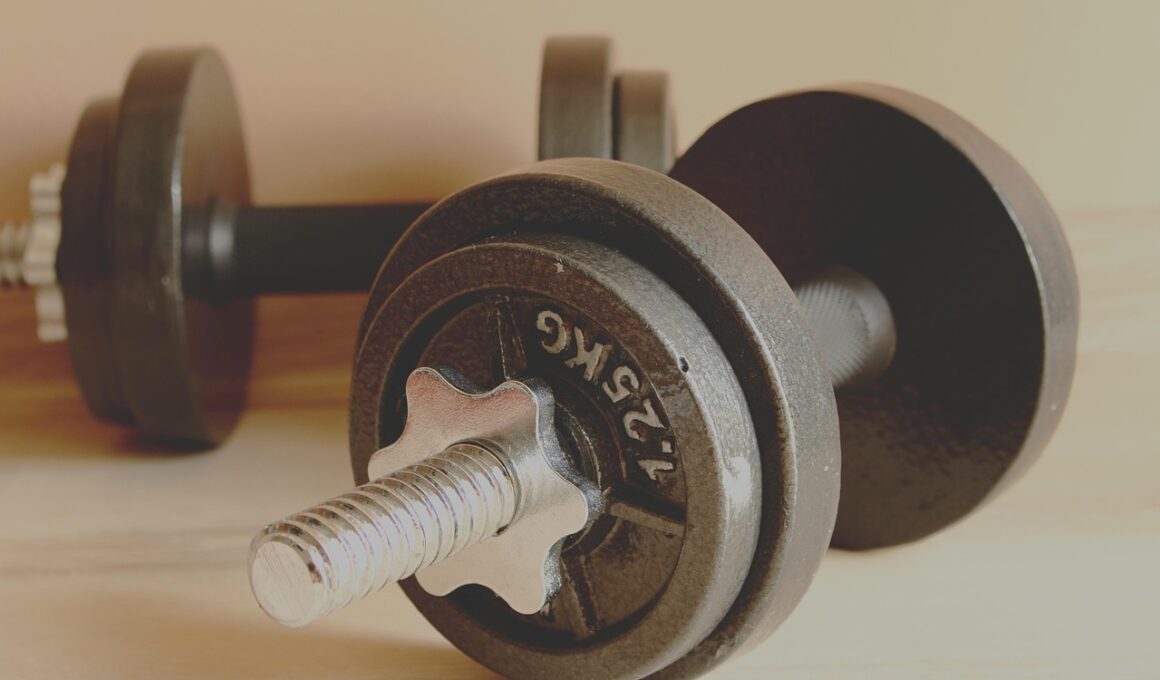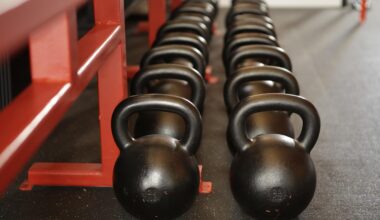Stretching Techniques to Increase Squat Depth
Increasing squat depth is crucial for better weightlifting performance. To achieve this, effective stretching techniques are vital for enhancing mobility. Incorporating flexibility exercises into your routine can help in this regard. Stretching is not just a warm-up; it enhances range of motion, improves muscle function, and reduces the risk of injury. Dynamic stretches before your workout can prepare your body for heavy lifting. These include leg swings and hip circles that address hip flexors. Static stretching after a workout helps in recovery. Focus on major muscle groups engaged during squats, like the quadriceps, hamstrings, and hip adductors. It is essential to hold each static stretch for at least 30 seconds to feel the beneficial effects. Remember that everyone has different mobility limits, so customize your stretches according to your body’s needs. Tools like resistance bands and foam rollers can aid stretching. Regularly integrating these techniques into your training will lead to noticeable improvements over time. With commitment and consistency, you will see enhancements in your squat depth and overall weightlifting performance.
One effective method for increasing squat depth involves targeting your hip flexors extensively. The hip flexors play a significant role in determining your overall squat depth. Tight hip flexors can restrict range of motion, compromising your squat performance. A recommended stretching exercise is the lunge stretch. Position yourself in a lunge, ensuring your front knee remains aligned over your ankle. Push your hips forward gently to feel the stretch in your hip flexor. Hold this position for up to 60 seconds before switching legs. Additionally, incorporating a pigeon pose into your routine helps open the hips significantly. Begin in a downward dog position, then bring one leg forward, bending at the knee. This pose stretches both the hip flexors and the glutes while improving mobility. Don’t forget about foam rolling. This technique addresses muscle tightness and improves tissue quality. Spend several minutes foam rolling your quadriceps and glutes before your stretches. This process prepares the muscles to be more pliable and receptive to stretching, enhancing your results. By committing time to target these muscle groups, your squat depth will substantially improve with practice.
Utilizing Dynamic Stretches
Dynamic stretches are perfect for warming up your body pre-workout. Unlike static stretches, which focus on muscle elongation, dynamic stretches mimic the movements you plan to perform. Incorporate leg swings into your routine to enhance your mobility. While holding onto a wall or a sturdy object, swing one leg back and forth to loosen the hip joint. This motion helps engage the muscles while preparing them for heavier lifts. Another effective dynamic stretch is the walking lunge. When performed with proper form, lunges activate the major muscle groups involved in squats. Focus on maintaining a straight back and ensuring the knee doesn’t go beyond your toes. Another useful exercise is the high-knee march. This promotes flexibility while also incorporating cardiovascular benefits into your warm-up routine. You can also include hip circles, which help lubricate the hip joint. Perform these movements gradually, ensuring you maintain proper posture at all times. Dynamic stretching sets the tone for your workout, enhancing performance by physically preparing the body for challenges ahead. This improves not just squat depth but overall weightlifting outcomes as well.
A well-rounded routine also incorporates stretches focused on the lower body and anatomical structures. For instance, the calf stretch is often overlooked but is necessary. Strong calf muscles provide stability and power when squatting. To perform this, stand close to a wall, place your hands on it, and position one leg straight behind you. Lean into the wall for an effective stretch of the calf muscle. Next, try the hamstring stretch. This can be done while sitting on the floor, ensuring one leg is extended while the other is bent towards your inner thigh. Reach towards the toes of the extended leg while keeping your back straight. Hold this position to enhance flexibility significantly. The butterfly stretch is another key addition to your routine. This targets the inner thigh muscles closing the gap on flexibility needed for deep squats. While seated, bring the soles of your feet together and gently push your knees towards the floor. Incorporating these stretches daily can lead to substantial improvements in flexibility. Ultimately, it allows for a more profound and effective squat.
The Importance of Consistency
When embarking on a mobility improvement journey, consistency is paramount to achieving results. Stretching should be seen as an integral part of your overall weightlifting program. You cannot expect significant changes overnight; patience is key. Make it a habit to include stretching exercises in your daily routine. Allocate specific days dedicated solely to flexibility work alongside your weights training. Document your progress, as this serves as motivation to continue. Adjust your stretches as your flexibility improves, ensuring you challenge your body effectively. Remember to engage in deep breathing during your stretches, as this helps reduce tension. Breathing helps to relax the body, allowing for deeper stretches and improved outcomes. Attend group classes focused on flexibility to inspire you regularly as well. Joining a community promotes accountability and offers new techniques to discuss. Sharing experiences and tips with others experiencing a similar journey fosters camaraderie and motivation. Remember, flexibility translates into better performance and prevents injuries. Continuing to work consistently towards improving mobility ensures that over time, you will notice significant progress in your squat depth.
Aside from routine practice, monitoring your nutrition plays a critical role in your weightlifting journey. Proper hydration and nutrition support muscle recovery and flexibility. Consuming protein-rich foods aids muscle repair, while healthy fats and carbohydrates fuel your workouts. Additionally, incorporating nutrient-dense vegetables can promote overall health and wellness. Micronutrients in vegetables play a significant role in maintaining healthy fascia. Foods rich in omega-3 fatty acids benefit joint health, making them vital for weightlifters. Consider supplements to support your flexibility objectives, such as magnesium, which aids muscle relaxation. Staying hydrated not only benefits your physical performance but enhances muscle pliability, making it easier to stretch effectively. Focus on protein-rich post-workout snacks to optimize recovery. Eating within 30 minutes after training assists muscles in rebuilding effectively. Good hydration practices mustn’t be overlooked; drinking water influences flexibility positively. By following these guidelines, you will be on a path to not only improve squat depth but also overall strength and overall performance. This holistic approach will yield impressive results in both your flexibility and weightlifting capabilities.
Seeking Professional Guidance
Finally, consider seeking professional help for tailored mobility programs. Trainers often have extensive experience helping athletes reach their potential. If you struggle with flexibility or mobility, consult a certified trainer or physical therapist. They can assess your current state and recommend appropriate stretches specifically for you. Professional guidance ensures that you learn the correct techniques, reducing the risk of injury. Trainers often provide valuable feedback on your form, maximizing the benefits of your stretching routine. They can suggest modifications based on any unique limitations you may have. Even a few sessions with a professional can bring swift results. Utilizing their expertise, you can discover new stretches and mobility drills to incorporate into your routine effectively. Furthermore, occasionally reassessing your progress alongside a professional is essential. This monitoring helps to keep you on track, making adjustments as needed to optimize your program. Whether you’re a beginner or have years of experience, investing in professional guidance can elevate your training. Make stretching and mobility a priority, and with time, dedication, and support, your squat depth will reach new heights.
In conclusion, increasing squat depth through effective stretching techniques is key for improving your weightlifting performance. A comprehensive approach involving a combination of dynamic and static stretches will yield the best results. Focus on specific areas like hip flexors, calves, quadriceps, and hamstrings to enhance overall flexibility. Moreover, consistency in your routine combined with proper nutrition supports your body’s flexibility needs. Remember to listen to your body and allow adequate time for recovery. By balancing your training with stretching, you will gradually notice significant enhancements in your squat depth. Seek professional guidance if necessary, as it can provide you with customized stretching plans suited to your personal requirements. A well-rounded weightlifting approach incorporates both strength training and flexibility work, ultimately contributing to your overall success. Keep track of your progress, adapt your routine when needed, and remain patient through the process. This journey will lead to remarkable improvements in your weightlifting capabilities, enabling you to perform at your best. Incorporate these techniques today, and begin to see how far your squats can go!


